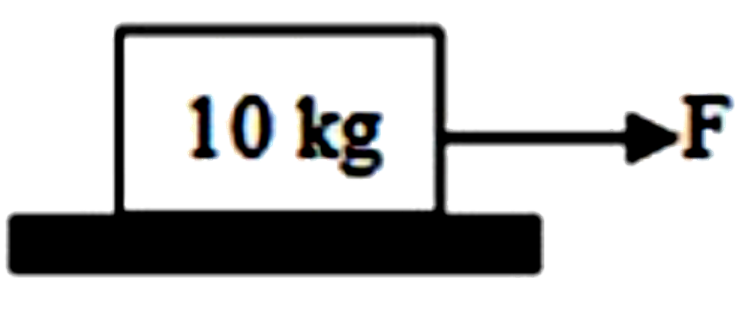A time varying force F=6t−2t2N, at t=0 starts acting on a body of mass 2kg initially at rest, where t is in second. The force is withdrawn just at the instant when the body comes to rest again. We can see that at t=0 the force F=0. Now answer the following:
Mark the correct statement:
Velocity of the body is maximum when force acting on the body is maximum for the first time.
The velocity of the body becomes maximum when force acting on the body becomes zero again.
When force becomes zero again, velocity of the body also becomes zero at that instant.
All of the above
The correct Answer is:B
To solve the problem, we will analyze the time-varying force and its effect on the motion of the body. The force is given by:
F(t)=6t−2t2N
The mass of the body is:
m=2kg
Step 1: Determine when the force becomes zero
To find out when the force becomes zero, we set the force equation to zero:
6t−2t2=0
Factoring out t:
t(6−2t)=0
This gives us two solutions:
1. t=0
2. 6−2t=0 which simplifies to t=3
Step 2: Analyze the motion of the body
The force acts on the body from t=0 to t=3 seconds. We need to find the velocity of the body when the force is withdrawn (i.e., at t=3 seconds).
Step 3: Calculate acceleration
The acceleration a(t) can be calculated using Newton's second law:
a(t)=F(t)m=6t−2t22=3t−t2
Step 4: Integrate acceleration to find velocity
To find the velocity, we integrate the acceleration with respect to time:
dvdt=3t−t2
Integrating both sides from t=0 to t=T and v=0 to v=V:
∫V0dv=∫T0(3t−t2)dt
Calculating the right-hand side:
V=(3t22−t33)T0=3T22−T33
Step 5: Substitute T=3
Now substituting T=3:
V=3(32)2−(33)3=3×92−273
Calculating:
V=272−9=272−182=92m/s
Step 6: Conclusion
At t=3 seconds, the velocity of the body is 92m/s, which is not zero. Therefore, the correct statement is:
- The velocity of the body will become maximum when the force acting on the body becomes zero again.
To find out when the force becomes zero, we set the force equation to zero:
2. 6−2t=0 which simplifies to t=3
The force acts on the body from t=0 to t=3 seconds. We need to find the velocity of the body when the force is withdrawn (i.e., at t=3 seconds).
The acceleration a(t) can be calculated using Newton's second law:
To find the velocity, we integrate the acceleration with respect to time:
Now substituting T=3:
At t=3 seconds, the velocity of the body is 92m/s, which is not zero. Therefore, the correct statement is:
Topper's Solved these Questions
- NEWTON'S LAWS OF MOTION 1Book:CENGAGE PHYSICS ENGLISHChapter:NEWTON'S LAWS OF MOTION 1Exercise:Integer
Explore 5 Videos
- NEWTON'S LAWS OF MOTION 1Book:CENGAGE PHYSICS ENGLISHChapter:NEWTON'S LAWS OF MOTION 1Exercise:Assertion-reasoning
Explore 15 Videos
- MISCELLANEOUS VOLUME 2Book:CENGAGE PHYSICS ENGLISHChapter:MISCELLANEOUS VOLUME 2Exercise:INTEGER_TYPE
Explore 10 Videos
- NEWTON'S LAWS OF MOTION 2Book:CENGAGE PHYSICS ENGLISHChapter:NEWTON'S LAWS OF MOTION 2Exercise:Integer type
Explore 1 Video
Similar Questions
A time varying force F=6t−2t2N, at t=0 starts acting on a body of mass 2kg initially at rest, where t is in second. The force is withdrawn just at the instant when the body comes to rest again. We can see that at t=0 the force F=0. Now answer the following:
Find the duration for which the force acts on the body.
View SolutionA time varying force F=6t−2t2N, at t=0 starts acting on a body of mass 2kg initially at rest, where t is in second. The force is withdrawn just at the instant when the body comes to rest again. We can see that at t=0 the force F=0. Now answer the following:
Find the time when the velocity attained by the body is maximum.
View SolutionA force acts for 0.1 s on a body of mass 2 kg initially at rest. The force is then withdrawn and the body moves with a velocity of 2 m/s. Find the magnitude of force.
View SolutionA force of 10 N acts on a body of mass 2 kg for 3s , initially at rest. Calculate the velocity acquired by the body
View SolutionA force acts for 0.1 s on a body of mass 2.0 kg initially at rest. The force is then withdrawn and the body moves with a velocity of 2m s−1. Find the magnitude of the force.
View SolutionA force of 10 N acts on a body of mass 2 kg for 3s , initially at rest. Calculate change in momentum of the body.
View SolutionA force acts for 0.1 s on a body of mass 1.2 kg initially at rest. The force then ceases to act and the body moves thorugh 2 m in the next 1.0 s . Find the magnitude of force.
View SolutionThe displacement of a body of mass 2kg varies with time t as S=t2+2t, where S is in seconds. The work done by all the forces acting on the body during the time interval t=2s to t=4s is
View SolutionA force F=2t2 is applied to the cart of mass 10 Kg, initially at rest. The speed of the cart at t = 5 s is -

View SolutionA body of mass 0.5 kg initially at rest is accelerating , due to a time dependent force [→F=tˆi+√tˆj] N then instantaneous power developed due to this force at t = 3 s will be
View Solution